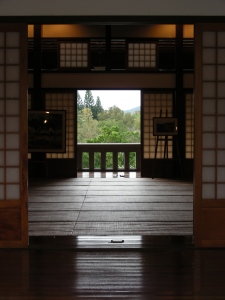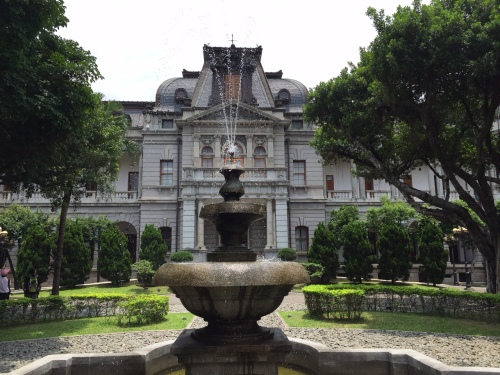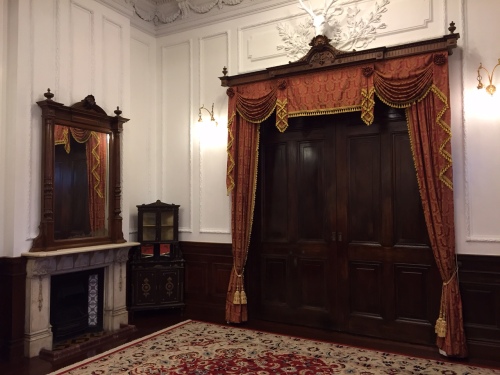A half-day walking tour in and around BeiTou Park (北投公園) is a relatively relaxing and cheap cultural journey to one of the premiere playgrounds of Taiwan’s Japanese era.
By Stuart Hill

The picturesque BeiTou Park and surrounding hot spring guesthouses have drawn people to this section of Taipei for over a century.
Whether or not you like taking hot springs, a visit to the volcanic valley of BeiTou (北投) gives you some sense of how the Japanese spent their leisure time.
Just a quick trip along Taipei’s red MRT line heading toward DanShui, the BeiTou hot springs are an easy walk from the New BeiTou MRT station. (Note: You’ll have to make the switch at BeiTou for the one-stop feeder line to New BeiTou.)
As a basic itinerary start at the bottom of the park and continue to make your way up the hill toward the Taiwan Folk Arts Museum and then wind your way back down. You can catch a local bus near the highest point of the park and at various stops up the hill. On the way back you can get off the bus next to the entrance to the park opposite the MRT station — more or less where your adventure began.
Key BeiTou Park Highlights:
- BeiTou Park, including the local library built from timber
- BeiTou Hot Springs Museum
- Open Air Public Hot Springs
- PuJi Temple
- Hell Valley
- Taiwan Folk Arts Museum
- Old houses and hot spring guesthouses viewed from the steep road up to the Taiwan Folk Arts Museum
BeiTou Park And Its Surrounds

The BeiTou branch of Taipei's municipal library is nestled among the trees in BeiTou Park
The BeiTou Park extends around the BeiTou Creek and was designed as a recreational area during the Japanese era. If you walk through the center of the park, you’ll come to the local library made out of stone, steel and wood.
Nearby is the Hot Spring Museum, which is definitely worth a look. There are volunteer guides and lots of photos, but unfortunately not much information is available in English. However, you can get a sense of the majesty of the place simply by looking.
The museum used to be a working bathhouse and was designed to offer a civilized space where public bathing was permitted — a kind of counter to the indecent habit of bathing in the nearby creek.

After a relaxing bath downstairs, patrons would relax upstairs in the tatami room overlooking the BeiTou Park gardens.
The lower level of the building housed the huge pool you can see today (which is now empty except for naturally occurring seepage), while upstairs people could sit and relax with views of the surrounding gardens.
Further up the hill, accessed by the road on the edge of BeiTou Park, is the Open Air Hot Springs. These working baths are pretty popular with local families and tourists and can be very busy. Rules state that you need to wear a swim suit too.
Next door, and just a little further up the road is the entrance to a renovated Japanese-style residence which is now open to the public.
At the end of the park, head along ZhongShan Road to the left. The road curves over a slight incline to reveal the entrance to Hell Valley, which is gated closed on Mondays. Hell Valley is actually a huge steamy pool of boiling water. During wetter months, the water is higher and there is more of a flow in and out of the pool. Cold months are spectacular as the pool surface and people standing by can disappear in the swirling sulfur mist. The heaviness of the air and the acidic smell can get to you though.

Acrid steam rises from the surface of the green sulfur pool that gives Hell Valley in BeiTou its name.
There is a small structure at the entrance to Hell Valley that showcases rock samples made from BeiTou’s famous therapeutic mineral Hokutolite. There are public toilets under this structure.
As you make your way out of Hell Valley back the way you came, follow the road to the left. You are back at the top end of the park. There is a bus stop nearby for the mini-bus that can take you up the hill to the Folk Arts Museum. Alternatively, follow the road away from the park heading right (opposite direction to Hell Valley). You’ll soon find steep stone steps leading up to PuJi temple.
The road up to the Folk Arts Museum is narrow and steep. There is just enough space in places to fit a small mini-van like bus. These once picturesque streets were dotted with Japanese hot spring guesthouses. Kamikaze pilots were known to spend their final hours in total ecstasy before heading off on their last missions.
There are still remnants of the Japanese architecture of the time along the road. What hasn’t been adapted for more modern-day use can be seen hidden behind high walls perched along the hill.
If you are catching the bus, it is easy to miss the Folk Arts Museum. The building itself is set down a driveway on the lower side of the road. The bus passes it and turns the corner before reaching the nearest stop. It is about a 2-3 minute walk back down the hill to the museum driveway.

The Taiwan Folk Arts Museum is a tranquil destination that offers a taste of the Japanese era in Taiwan.
While the museum’s primary function is to showcase examples of Taiwan’s folk art and handcrafts, in fact the building is interesting in its own right. It was a two-storey Japanese hot spring inn originally built around 1921, featuring a massive top-floor sitting and performance area. After 1945, the building was taken over by the ROC Ministry of Foreign Affairs and used to house troops and their families. The building was auctioned off to private interests and between 2002-2008 was brilliantly restored and thankfully rescued from neglect, white ants, and the elements. It now represents one of the largest examples of a freestanding wooden building from the Japanese era.
The design and location of each room would have offered an exceptional form of luxury in its heyday, with commanding views of the valley below. That said, the second floor entertainment space is still amazing.

Get a feel for the leisurely lives of the Japanese in the I-Ran Tea House, Taiwan Folk Arts Museum.
The museum is a private enterprise, so there is an entry fee (adults NT$120). As the old inn included hot spring baths, there is a full explanation about the original facilities and their restoration. Information also highlights the importance of BeiTou as an entertainment district to the Japanese. Note, that the baths are not available for use and simply form part of the museum. In the central rooms of the museum you can view various displays of folk art and aboriginal artifacts.
Next to the entrance there is a gift and book shop with a range of stylish Taiwanese-themed handicrafts and other products.
Close to the gift shop is a place to buy a simple lunch set. The I-Ran Japanese Tea House which faces down the valley, provides a tranquil place to drink tea, chat, or simply soak up the ambience.
More Information:
Other Taiwan Travel Ideas:










